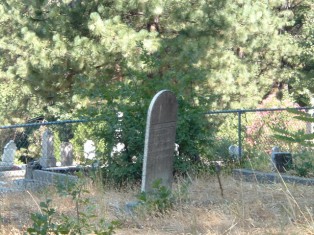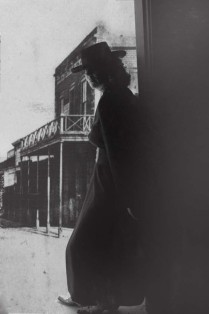What an extreme pleasure it was to meet descendants of Cherokee lawman Sam Sixkiller this weekend in Oklahoma. Such lovely people one and all and they generously shared photographs of Captain Sixkiller’s children and grandchildren with me. I learned a great deal more about the lawman and the Nation he protected. Colcord, Oklahoma is one of the most friendly towns I ever visited and I couldn’t help but imagine Sixkiller patrolling the area. On my way home I was reminded of a lawman who made his mark on this area of California. His name was David Douglass and a short account of his life is included in the book Tales Behind the Tombstones. Douglass was elected to the post of Nevada County sheriff in 1894. Sheriff Douglass had been a guard for gold shipments traveling by train and had also served as a messenger for Wells Fargo. He was known by residents in Grass Valley and Nevada City, California, as a bold, fearless, and defiant officer, dedicated to making sure the law was upheld. On Sunday, July 26, 1896, Douglass set out after an outlaw named C. Meyers who had been terrorizing the country. The pursuit ended in the death of the bandit and the sheriff. Sheriff Douglass shot and killed the highwaymen, but just who shot Douglass remains a mystery. After learning where the thief was hiding out, Douglass, mounted his horse and took out after him. When the sheriff hadn’t returned by the next day, his friends and deputies combed the area looking for him. His body was discovered a few feet from the outlaw’s. Cedar and chaparral trees were thick around the secluded scene, and it was evident to the sheriff’s deputies that he had been lured to the spot. Sheriff Douglass’s body was found with his head pointing downhill, his face plunged in the brush and dirt. The Grass Valley Union newspaper reported that the “force of the fall brought a slight contusion to the forehead.” Those who discovered his body believed that the bullet that took his life had entered his back, thrusting him forward. The report quoted deputies as saying, “Undoubtedly Sheriff Douglass had shot Meyers dead and was going to inspect the damage when a bullet pierced his frame.” As subsequent facts developed it appeared there had been an accomplice of Meyers hiding somewhere in the area. The unknown shooter fired shots at Douglass. The first bullet went into his back on the left side, and the second hit him in the right hand. Nevada County residents were shocked by the news of the respected sheriff’s death. They arrived in droves at the scene of the tragedy hoping to find a clue as to who the murderer might have been. Dozens of well-armed men scoured the hills in search of the assassin. The killer was never found. A monument to the memory of the sheriff and the outlaw (buried at the site) was erected at the location of the tragic gunfight in early 1900. It is believed Douglass was pitted against two and then one escaped. The bodies were lying parallel to one another. The gravestone over Sheriff Douglass’s grave and that of the bandit he shot is located in the Tahoe National Forest in Nevada City, California on a dirt pathway on Old Airport Road.
Journal Notes
The Lone Grave
It was the news of gold that let loose a flood of humanity upon the foothills of Northern California. Prior to 1849 most west-heading wagons were bound for Oregon. All at once settlers burst onto the scene searching for their fortune in gold. Some found what they hoped for, but others found nothting but tragedy. Such was the case for the Apperson family, pioneers who lost a young family member in a fiery accident in 1858. The wagon train the sojourners were a part of struggled to make its way over the treacherous Sierra Nevadas and down the other side into the valley below. The appersons and their fellow travelers were exhausted from the four-month overland trip, which had started in Independence, Missouri. After reaching the outskirts of the mining community of Nevada City, California, they made camp as usual and rested for a few days before moving the train on into town. The forest settling was idyllic, and the Appersons decided to stay there instead of going on with the others. They built a home for themselves and their four children. For a while they were truly happy. But on May 6, 1858, an unfortunate accident occurred that left them devastated. At their father’s request the Apperson children were dutifully burning household debris when the youngest boy, barely two years old, wandered too close to the flames, and his pant leg caught fire. His sister and brothers tried desperately to extinguish the flames but were unsussessful. The boy’s mother heard his frantic screams and hurried to her child. She smothered him with her dress and apron, and then quickly rushed him to a nearby waterng trough and immersed his body. The child’s legs and sides were severly burned, but he survived. For a time it seemed as though his injuries might not be life threatening. The boy lingered for a month and then died. He was buried at the southwest corner of their property. The Apperson family stayed only a few months after his death and then moved on. At the time of his passing, the grave was marked only by two small seedlings. Since then concerned neighbors and community leaders have taken an interest in the burial site, surrounding the small spot with a fence and a marker. Motorists driving along U.S. Highway 20 from Nevada City frequently stop to visit the lone grave beside the road. It lies to one side of the interstate between two large cedars. A stone plaque now stands over the place where the child lies. Donated by the Native Sons of the Golden West, the plaque reads Julius Albert Apperson, Born June 1855. Died May 6, 1858. A Pioneer Who Crossed The Plain To California Who Died And Was Buried Here. The Emigrant Trail followed along the ridge and through Nevada City. The marking of this lone grave perpetuates the memory of all the lone graves throughout the state. Not only does the plaque signify the grave as a historic landmark, it stands as a symbol of sacrifice.
Outcast Cemetery
Sam Sixkiller Now Available

Sam Sixkiller was one of the most accomplished lawmen in 1880s Oklahoma Territory. And in many ways, he was a typical law-enforcement official, minding the peace and gunslinging in the still-wild West. What set Sam Sixkiller apart was his Cherokee heritage. Sixkiller’s sworn duty was to uphold the law, but he also took it upon himself to protect the traditional way of life of the Cherokee. Sixkiller’s temper, actions, and convictions earned him more than a few enemies, and in 1886 he was assassinated in an ambush. This new biography takes a sweeping, cinematic look at the short, tragic life of Sam Sixkiller and his days policing the streets of the Wild West.
Object Matrimony Available in bookstores everywhere October 2, 2012
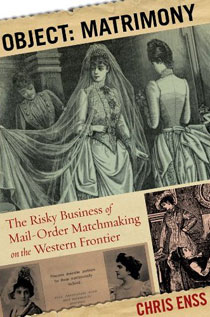
Desperate to strike it rich or eager for free land, men went into the frontier West alone and sacrificed many creature comforts. Only after they arrived at their destinations did some of them realize how much they missed female companionship.
One way for men living on the frontier to meet women was through subscriptions to heart-and-hand clubs. The men received newspapers with information about women with whom they could correspond—sometimes with photographs. Eventually a man might convince a woman to join him in the West, and in matrimony.
Complete with historic photographs and actual advertisements from both women seeking husbands and men seeking brides, Object Matrimony includes stories of courageous mail order brides and their exploits as well as stories of the marriage brokers, the mercenary matchmakers looking to profit off of the miners and settlers. Some of these stories end happily ever after; others reveal desperate situations that robbed the brides of their youth and sometimes their lives.
More Outlaw Tales of California Available in October of 2012
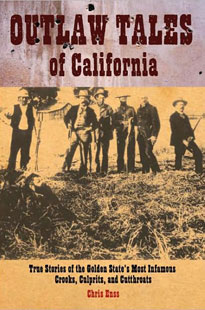
From the world-famous to the relatively obscure, Outlaw Tales of California features true tales of fifteen bandits, outlaws, and no-good scoundrels. From Sacramento to Los Angeles, San Francisco to Nevada City, the frontier towns of California were populated by some of the toughest and most dangerous characters in the West. Tom Bell, the flat-nosed, felon doctor had his “Catch me if you can!” motto finally catch up to him when he was hanged after a wild eighteen-month career as an outlaw. Lawman-gone-bad Henry Plummer got twisted up in a lascivious love affair. And bad luck bandit Dick Fellows never could catch a break—except for in his leg and ankle. From Charles Earl “Black Bart” Boles to “Rattlesnake Dick” Barter, Juan Flores to Joaquin Murieta, read about the most notorious desperados in the history of the Golden State. Through these astonishing true stories, Outlaw Tales of California introduces you to a state you thought you knew—and a West that was wilder than you’ve ever imagined.
Confessions of a Killer
Thunder Over the Prairie Soon to be a Major Motion Picture
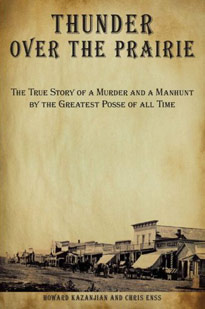
The year was 1878. Future legends of the Old West–lawmen Charlie Bassett, Bat Masterson, Wyatt Earp, and Bill Tilghman–patrolled the unruly streets of Dodge City, Kansas, then known as “the wickedest little city in America.”
When a cattle baron fled town after allegedly shooting the popular dancehall girl Dora Hand, these four men–all sharpshooters who knew the surrounding harsh, desertlike terrain–hunted him down, it was said, like “thunder over the prairie.” The posse’s legendary ride across the desolate landscape to seek justice influenced the men’s friendship, careers, and feelings about the justice system. This account of that event is a fast-paced, unforgettable glimpse into the Old West.

